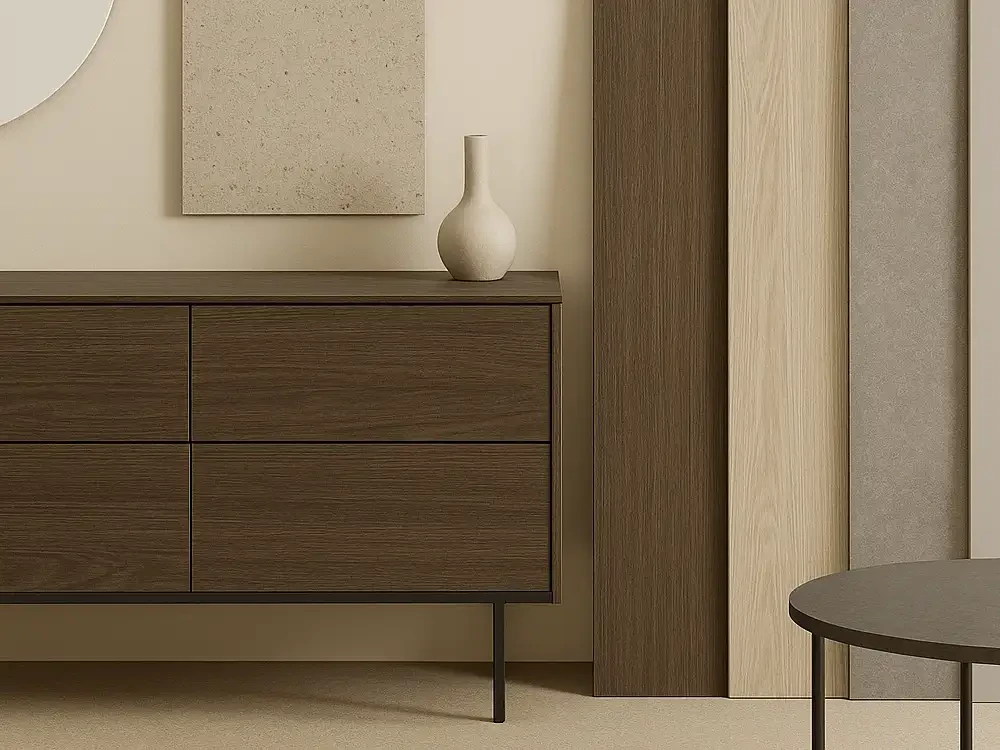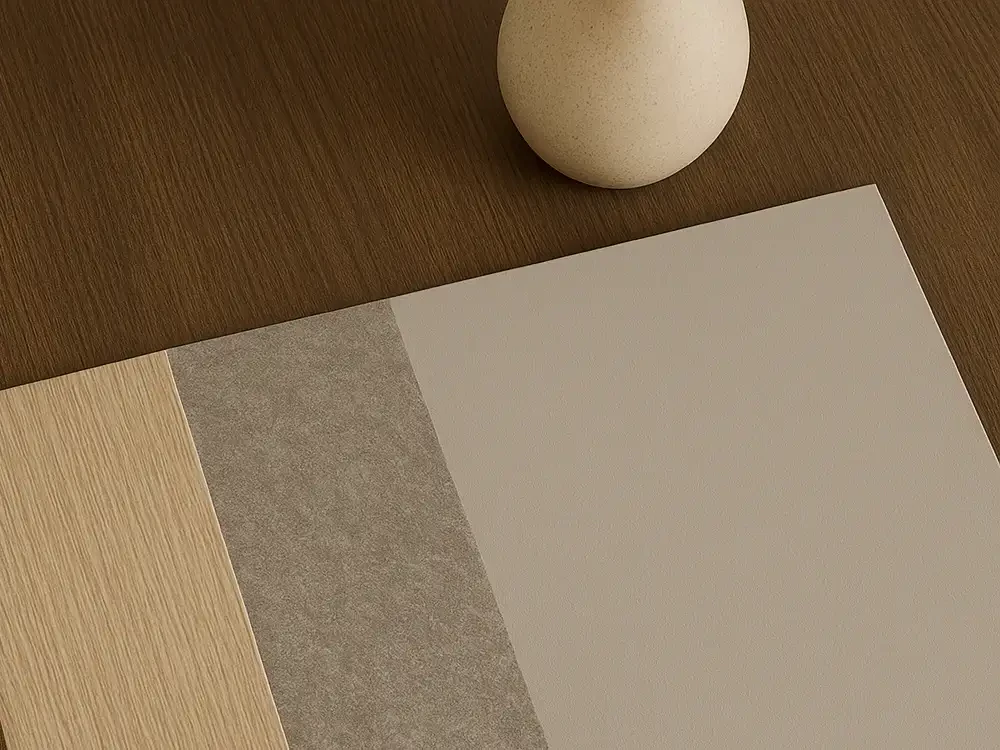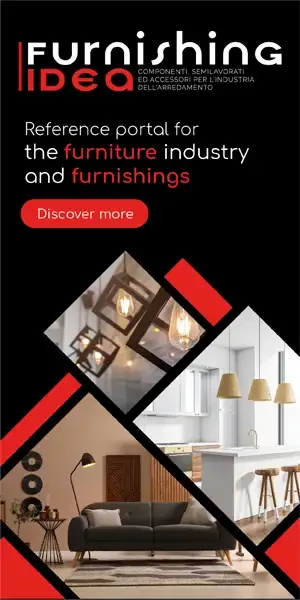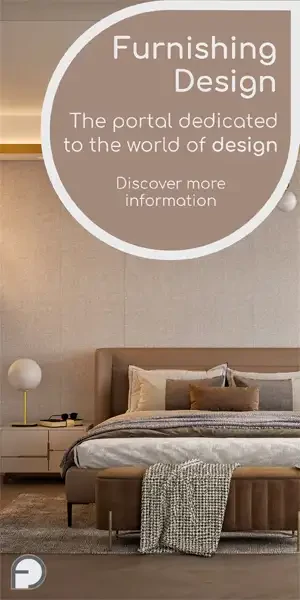
- 06/11/2025
- Melamine surfaces
The melamine panel is a technical decorative surface used in furniture manufacturing to make cabinets, doors, tops and claddings.
It consists of a wood-based core (usually particleboard or MDF) covered by decorative paper impregnated with melamine resins.
This combination gives the material durability, stability and a customizable aesthetic, making it one of the most popular choices in modern and contract furniture sectors.
Today the term “melamine surfaces” identifies a broad category of decorative materials that combine design, practicality and affordability.
How a melamine panel is produced
The production process of the melamine panel is divided into several phases, each affecting the final product quality:
- Choice of the core
A panel of particleboard, MDF or HDF is used, depending on the application: standard, moisture-resistant or fire-retardant. - Decoration preparation
A decorative paper printed with wood, stone or concrete effect patterns is impregnated with melamine resin, a thermosetting substance that creates a protective film. - Pressing and finishing
Under high temperature and pressure, the melamine paper fuses with the core, forming a compact surface, smooth or textured, ready for machining and edge-banding.
The result is a uniform, durable and versatile surface, capable of reproducing natural textures or realistic material effects, at contained costs.
Main characteristics of melamine surfaces
Melamine surfaces stand out for some key technical characteristics:
- Scratch and stain resistance
Thanks to the melamine coating, the panel is protected from wear and superficial abrasion. - Dimensional stability
The MDF or particleboard core ensures rigidity and flatness over time. - Aesthetic variety
It is possible to faithfully reproduce wood grains, stones, concrete and solid colors, with tactile or matte textures. - Compatibility with other materials
Melamine surfaces can be combined with glass, metal or HPL surfaces to create custom furniture.
Advantages of the melamine panel
The success of melamine is linked to the combination of technical performance and practical advantages.
- Wide aesthetic freedom
Printing and embossing technologies allow very realistic and customizable surfaces, perfect for kitchens, living rooms, offices and commercial spaces. - Competitive price
Melamine offers an excellent value for money: it provides the look of wood or stone at significantly lower costs compared to natural materials or HPL laminate. - Easy maintenance
It is easy to clean: a damp cloth and neutral cleaners are enough. It does not require specific treatments, which makes it ideal for domestic and contract environments. - Sustainable material
Advanced manufacturers use recycled cores and low-emission resins, making melamine a choice consistent with sustainable design.

Disadvantages and limitations of melamine
Despite its widespread use, the melamine panel also has some limitations to consider.
- Limited moisture resistance
Standard melamine can be damaged by prolonged contact with water or steam. For bathrooms and kitchens a specific moisture-resistant core is recommended. - Reduced repairability
Unlike solid wood, it cannot be sanded or repaired in case of deep scratches or impacts. - Inferior to HPL and technical materials
Compared to HPL laminate (High Pressure Laminate), melamine is less resistant to heat and pressure. However, it remains perfect for doors, sides and vertical furniture, where stresses are lower.
Differences between melamine and HPL laminate
Many users confuse the melamine panel with HPL laminate, but they are different materials:
| Characteristic | Melamine | HPL Laminate |
|---|---|---|
| Production pressure | Low | High |
| Coating thickness | Thin (0.2 mm) | Thicker (0.8 – 1 mm) |
| Mechanical resistance | Medium | High |
| Cost | Economical | Higher |
| Maintenance | Easy | Very easy |
| Recommended use | Furniture, doors, vertical claddings | Worktops, tables, high-traffic walls |
In summary, melamine is the most suitable choice for interior furniture, while HPL is better suited for surfaces exposed to impact, heat and heavy wear.
When to choose melamine surfaces
Melamine surfaces are ideal for:
- Modern kitchens and living areas: thanks to wood or concrete effect textures.
- Bedrooms and wardrobes: for coordinated design at accessible costs.
- Contract furniture and offices: where practical, durable and repeatable materials are needed.
- Custom-made elements and wall paneling: easy to cut and combine with other materials.
The melamine panel is a modern, economical and versatile solution for the furniture world. It combines aesthetic beauty, practicality and sustainability, offering a wide range of finishes and textures for every type of project. While it does not replace technical materials like HPL or solid wood, it remains a smart choice for those seeking design and functionality at a competitive cost.

 en
en  Italian
Italian

